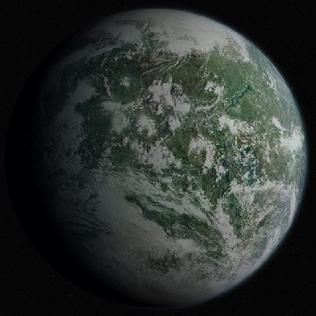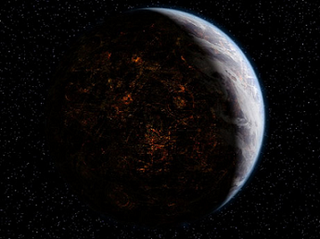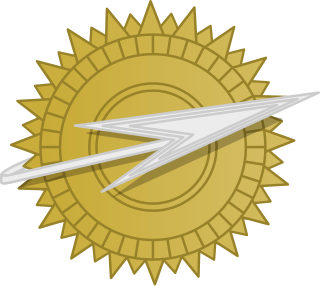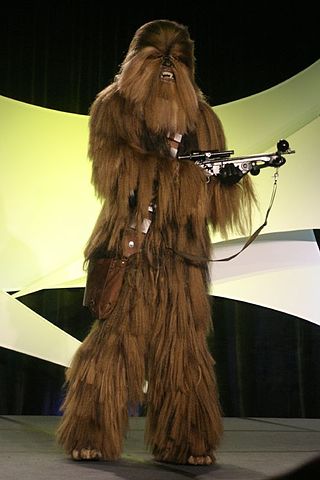
Dagobah is a fictional planet and eponymous star system appearing in the Star Wars films The Empire Strikes Back, Return of the Jedi, and Revenge of the Sith, and other media. It is depicted as a world of murky swamps, steaming bayous, and jungles, resembling Earth during the Carboniferous period. Dagobah is 14,410 kilometers in diameter with an orbital period of 341 days. Dagobah's climate and atmosphere consists of two seasons; a dry season, where the uplands become too hot for most life forms to survive; and a wet season, consisting of violent lightning storms, dense fog, and long periods of torrential rainfall. Tash were a sentient species native to Dagobah.

The Foundation series is a science fiction book series written by American author Isaac Asimov. First published as a series of short stories and novellas in 1942–50, and subsequently in three collections in 1951–53, for thirty years the series was a trilogy: Foundation; Foundation and Empire; and Second Foundation. It won the one-time Hugo Award for "Best All-Time Series" in 1966. Asimov began adding new volumes in 1981, with two sequels: Foundation's Edge and Foundation and Earth, and two prequels: Prelude to Foundation and Forward the Foundation.

The Galactic Empire is a fictional autocracy featured in the Star Wars franchise. It was first introduced in the 1977 film Star Wars and appears in its two sequels: The Empire Strikes Back (1980) and Return of the Jedi (1983). It is the main antagonistic faction of the original trilogy. An oppressive, autocratic regime with a complicated bureaucracy, the Galactic Empire seeks to ensure singular rule and social control over every planet and civilization within the galaxy.

The Rebel Alliance is a fictional organization in the Star Wars franchise. The Alliance is portrayed as a stateless coalition of rebel dissidenters and defectors who oppose the Galactic Empire and its authoritarian rule. Their goal is to restore the liberal governance of the previous Galactic Republic, which had been dissolved after its leader Palpatine seized absolute power and declared himself emperor. It is the main protagonist faction of the original Star Wars trilogy, parallel to the mostly fallen Jedi Order survived by Obi-Wan Kenobi, Yoda, and later Luke Skywalker.
Galactic empires are a common trope used in science fantasy and science fiction, particularly in works known as 'space operas'. Many authors have either used a galaxy-spanning empire as background or written about the growth and/or decline of such an empire. The capital of a galactic empire is frequently a core world, such as a planet relatively close to a galaxy's supermassive black hole, which has advanced considerably in science and technology compared to current human civilization. Characterizations can vary wildly from malevolent forces attacking sympathetic victims to apathetic bureaucracies to more reasonable entities focused on social progress and anywhere in between.

Coruscant is an ecumenopolis planet in the fictional Star Wars universe. Its first appearance was on screen in the 1997 Special Edition of Return of the Jedi, but was first depicted and mentioned by name in Timothy Zahn's 1991 novel Heir to the Empire. Coruscant is a prominent location in both canon and Legends media that has been produced. Within the narrative of the films, Coruscant-based locations such as the Jedi Temple and Jedi Archives act as the home for the Jedi and in plot terms are frequently used for exposition or to drive other elements of the plot.

The Galactic Republic, often referred to as simply the Republic, is a fictional galactic polity depicted in the Star Wars universe, where it existed prior to the establishment of the Galactic Empire. The Republic is most prominently portrayed in the prequel trilogy of films in the Star Wars franchise. In the original trilogy, set later in time, it is referred to as the Old Republic.

The Galactic Empire is an interstellar empire featured in Isaac Asimov's Robot, Galactic Empire, and Foundation series. The Empire is spread across the Milky Way galaxy and consists of almost 25 million planets settled exclusively by humans. For over 12 millennia the seat of imperial authority was located on the ecumenopolis of Trantor, whose population exceeded 40 billion, until it was sacked in the year 12,328. The official symbol of the empire is the Spaceship-and-Sun. Cleon II was the last Emperor to hold significant authority. The fall of the empire, modelled on the fall of the Roman Empire, is the subject of many of Asimov's novels.

Legend of the Galactic Heroes, sometimes abbreviated as LOTGH, LOGH, LGH or Gin'eiden (銀英伝) in Japanese, is a series of science fiction novels written by Yoshiki Tanaka. In humanity's distant future, two interstellar states – the monarchic Galactic Empire and the democratic Free Planets Alliance – are embroiled in a never-ending war. The story focuses on the exploits of rivals Reinhard von Lohengramm and Yang Wen-li, as they rise to power and fame in the Galactic Empire and the Free Planets Alliance, respectively.

4X is a subgenre of strategy-based computer and board games, and include both turn-based and real-time strategy titles. The gameplay involves building an empire. Emphasis is placed upon economic and technological development, as well as a range of military and non-military routes to supremacy.

Star Wars: Galactic Battlegrounds is a real-time strategy video game set in the Star Wars universe. It was developed by Ensemble Studios and LucasArts. It was released on November 11, 2001. An expansion pack, Clone Campaigns, was released on May 14, 2002, adding two new factions and campaigns. Later that year, both Galactic Battlegrounds and Clone Campaigns were released in a box set, Star Wars: Galactic Battlegrounds Saga.

Star Wars: Empire at War is a 2006 real-time strategy video game developed by Petroglyph Games and published by LucasArts. Set between Episode III and Episode IV, it focuses on the fledgling struggle between the Empire and the Rebels. It uses Petroglyph's game engine Alamo. In October 2006, an expansion titled Star Wars: Empire at War: Forces of Corruption was released. On May 31, 2014, online functionality, including network multiplayer and wireless chat, was discontinued after Glu Mobile's purchase of GameSpy and the subsequent shutdown of all game servers. As of September 1, 2017, the multiplayer has been re-enabled on the Steam version as well as workshop support being added.

Galactic Empire is a strategy video game written by Doug Carlston for the TRS-80 and released 1980. It is the first game in the Galactic Saga and became first game published by Broderbund which was, in fact, created for the purpose of publishing the game. Galactic Empire was ported to the Apple II and the Atari 8-bit family and followed by three sequels. The game was also published by Adventure International.

Galactic Civilizations II: Dread Lords is a 4X turn-based strategy by Stardock for Microsoft Windows. It is the sequel to the 2003 game, Galactic Civilizations, and was released at retail and on Stardock's online subscription service, TotalGaming.net, on February 21, 2006. An expansion, Dark Avatar, was released in February 2007. A second expansion, Twilight of the Arnor, was released in April 2008.
Starport: Galactic Empires is a free, space-oriented, massively multiplayer online role-playing game by American studio Playtechtonics which uses a third-person overhead view similar to that used in Asteroids. The game uses realistic 2-dimensional physics for both space and atmospheric travel, affecting both the movement of ships and player-fired weaponry. Characters can conquer and colonize planets with a variety of different terrains depending on the type of planet. The player can harvest resources, generate money, and produce weapons with their colony. Starport shares many core concepts with Tradewars 2002, notably the commodity trading and planet controlling aspects.

Wookiees are fictional humanoid aliens in the Star Wars universe, native to the forest planet Kashyyyk. They are distinguished from humans by their gigantism, hirsutism, and physical strength. The most prominent Wookiee is Chewbacca, co-pilot of the Millennium Falcon alongside his best friend Han Solo.

Spore Galactic Adventures is an expansion pack for the multigenre game Spore, developed by Maxis Emeryville and published by Electronic Arts. The US version of the game was released on June 23, 2009. The European version was released on June 26, 2009.
The Foundation universe is the future history of humanity's colonisation of the galaxy, spanning nearly 25,000 years, created through the gradual fusion of the Robot, Galactic Empire, and Foundation book series written by American author Isaac Asimov.

Galaxy is a 1981 video game published by Avalon Hill and developed by Microcomputer Games for the Apple II, TRS-80, Atari 8-bit family, Commodore PET, Commodore 64, IBM PC compatibles, FM-7, and TI-99/4A. It was originally published as Galactic Empires by Powersoft in 1979.















